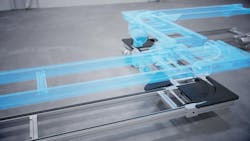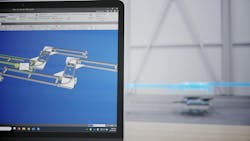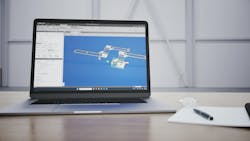How Digital Transformation Is Changing the Way Manufacturers Design Mechanical Systems
Remember when assembly was a predominately manual process? We still have pictures from installations in the 1980s showcasing this method of assembly operations. Lines of manual production systems with various bins of parts and workers at the helm putting pieces together with one unified goal.
Then, it evolved. Sensors, vision systems and cameras entered the picture—enabling increased accuracy and smoother workflows. As technology continues to advance, these same processes have evolved to include automated components such as robot integrations.
The point of this example is to provide an illustration of our evolving industry. The industry at Bosch Rexroth U.S.A’s inception in 1967 is wildly different than the industry we work in now; and adapting requires embracing new ways of approaching standard processes, such as mechanical system design.
A More Hands-on Approach
As the world becomes increasingly more digital, we see this impacting end-users in multiple ways, the most prominent being that they’re wanting to be more hands-on with their planning.
Evaluate our own shopping habits: Mobile ordering apps and online shopping have skyrocketed in popularity on the basis that consumers want to acquire product with minimal human interaction.
READ MORE: Conveyance Systems in Robotics Maximize Efficency
Now, a multi-line production system is more complex than a grocery order, so supplier collaboration will always be a required step in the automation space. But what can be adjusted is at what stage in the process an end-user approaches their supplier—and that’s where the digital transformation has truly made an impact.
Rather than relying on multiple sales and engineering contacts from a supplier to design and implement mechanical systems, end-users are looking for ways to bring that initial planning process in-house and then collaborate externally with suppliers to finish. To support end-users with this workflow, digital, self-serve tools are becoming increasingly more important for suppliers to offer.
The increase of digital tools like engineering software and CAD plug-ins in the market are a direct result of end-users wanting to bring the power to plan, calculate and document assembly systems into their control. Whether it’s an automated conveyor system, a profile rack or ergonomic workstation design, it is critical for suppliers to simplify the design process on the front end to enable smoother collaboration.
Enhancing Proven Products with Digital Tools
In the assembly technology space, digital transformation is a particularly interesting topic because it’s less about the introduction of newer technologies (although there are still advancements) and more about how digitization is enhancing experiences with proven, legacy products such as twin strand pallet conveyance or aluminum framing structures.
Consider an assembly line for an automotive motor: The base of the system will require a sturdy aluminum framing foundation, and a pallet-based conveyance system engineered for the heavy payload requirements. Perhaps additional components might be better discussed with external automation professionals, but with the right intuitive engineering tool, companies have it within their control to build out the skeleton of their new line (and with the right software, perhaps a bill of material for cost estimation).
READ MORE: Custom Conveyance Engineering: Meeting the Challenges of High-Throughput Facilities
Outside of design tools, process simulation software such as Visual Components enables suppliers to test a design via simulation and make tweaks before the process gets too far along. Our team recently exhibited the conception of a multi-conveyor line to showcase how much simpler the process can be from initial design to simulation to final system with digital engineering software.
For us, the exhibit demonstrated the shift in the industry towards a robust digital planning phase and how a supplier’s design tool portfolio can play a critical role in supporting their customer in the decision-making process, even for tried-and-true technology.
Smart “Add-ons” for Operational Transparency
It wouldn’t be a proper article about digital transformation without mentioning the integration of smart technology into legacy products. With advancements in controls, data collection, RFID and sensors, end-users have more transparency into their operations after installation than ever before.
Access to this data enables them to closely monitor their new system once it’s up and running, prevent unwanted downtime, and identify and resolve potential bottlenecks. While core assembly automation products like pallet-based conveyance have been around for decades, digital transformation has made a proven product even more durable with data.
The Digital Age of Supplier-end User Relationships
The increased usage of design software by end-users is causing a natural shift in how they collaborate with suppliers. Gone are the days of transactional relationships when end-users would simply select components from a catalog. Digital transformation is helping them take the first step and foster more collaborative conversation with suppliers, rather than total reliance.
About the Author

Geert van der Zalm
Vice President, Assembly Technology, Bosch Rexroth.
Geert van der Zalm is vice president, Assembly Technology at Bosch Rexroth.



